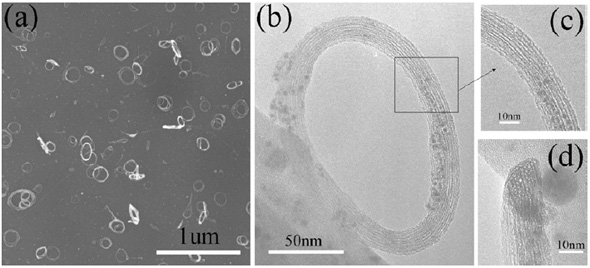| Posted: Apr 24, 2006 | |
The interesting transport properties of SWNT nanorings |
|
| (Nanowerk News) As a novel superstructure, single-walled carbon nanorings exhibit interesting transport properties, such as Aharonov-Bohm effects, magnetotransport or establishment of persistent currents. Researchers in China have developed a new technique to produce large quantities of small-diameter single-walled carbon nanotube (SWNT) nanorings. | |
| The controllable, large-scale synthesis of SWNT nanorings provides numerous opportunities for investigating transport, electronic and optical phenomena through a nanotube’s annular structures. Furthermore, this relatively simple method will provide a promising material (i.e. SWNT nanorings) for the realization of nanometer-scale electric circuits and magnetically induced changes in electronic structure. | |
| Professor Sishen Xie together with first author Dr. Li Song, both from the Institute of Physics at the Chinese Academy of Sciences in Beijing, reported that large scales of nanorings were prepared in a floating catalyst chemical vapor deposition (CVD) system. The rings obtained have a smaller diameter about 100 nm, compared with the rings produced in previous works. Their findings were reported in a recent paper titled "Efficiently producing single-walled carbon nanotube rings and investigation of their field emission properties" in the April 11, 2006 online edition of Nanotechnology. | |
| "We showed that the yield and the quality of nanorings could be further increased with more optimized growth parameters" Xie explained to Nanowerk. "In the field emission measurements, we found that field emission behavior from a halved SWNT ring is better than that from a whole nanoring, which is contributed to the better emission capability from two opened nanotubes ends of the halved nanoring." | |
 | |
| SEM (a) and TEM (b) images of SWNT rings. A high magnification TEM image of ring is shown in (c) and a cross-sectional HRTEM image of an SWNT ring in (d). (Reprinted with permission from IOP Publishing) | |
| And as a remarkable advantage for potential applications such as electric devices, the nanorings were deposited at relatively low temperature with wide density range on different substrates. "The sublimation temperature of the catalyst of between 52-58°C was shown to be a crucial factor for producing the SWNT nanorings" says Song. | |
| Many post-treated methods have been developed to fold linear nanotubes into a ring structure, for example by inducing with ultrasonic irradiation or covalent ring-closure reactions. Trace quantities of nanorings (<0.1%) have been accidentally observed in directly synthesized materials. However, rings with low yield were neither reproducible nor was their synthesis controllable so as to offer any relevant technological applications on a large-scale. | |
| Furthermore, in most previous work, the nanorings observed had a diameters in excess of 300nm although, in theory, rings with curvature radii much smaller than 100nm can be generated in principle. | |
| Looking forward, the low temperature deposition allows the integration of the rings with silicon and MEMS technology. | |
| "Our synthesis method for SWNT nanorings will provide promising materials for building nano-scale electronic circuits. For example, a ring can be seen as a nano solenoid and exhibit a tiny electrical magnet, which can be used as a smallest magnetic tip in magnetic force microscopy" says Song. | |
| Xie explains the future direction of their research: "We will focus on the investigation of Aharonov-Bohm effects in nanorings with annular geometry and the fabrication of nanorings-based electronic nano-devices" he says. | |
 By
Michael
Berger
– Michael is author of three books by the Royal Society of Chemistry:
Nano-Society: Pushing the Boundaries of Technology,
Nanotechnology: The Future is Tiny, and
Nanoengineering: The Skills and Tools Making Technology Invisible
Copyright ©
Nanowerk LLC
By
Michael
Berger
– Michael is author of three books by the Royal Society of Chemistry:
Nano-Society: Pushing the Boundaries of Technology,
Nanotechnology: The Future is Tiny, and
Nanoengineering: The Skills and Tools Making Technology Invisible
Copyright ©
Nanowerk LLC
|
Become a Spotlight guest author! Join our large and growing group of guest contributors. Have you just published a scientific paper or have other exciting developments to share with the nanotechnology community? Here is how to publish on nanowerk.com.
